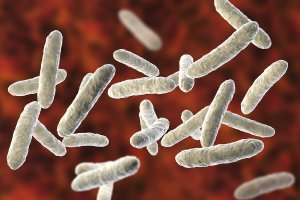The Microbiota: Everything you Need to Know

The digestive system in the human body is very complex. Among some of its most impressive features is the fact that almost a third of our total number of neurons are located there, forming nervous plexuses. But perhaps the most important characteristic is that there are millions of bacteria living in our large intestine and coexisting with us in symbiosis. These bacteria form what we know as gut flora or microbiota, and they’re indispensable for our health.
The microbiota
The microbiota or microbiome is a cluster of microorganisms that are naturally present in different parts of the human body. We can normally find bacteria in areas as varied as the skin, the pharynx, the urethra or the esophagus.
However, it’s in the colon where there’s actually a complex ecosystem of bacteria that live inside of us without causing any harm. There are more than 100 billion unicellular microorganisms living there. It’s more than the total number of cells in our body, and even then, they only weigh around 2.2 pounds in an adult human.
While there’s a belief that bacteria are bad for our health, there’s nothing further from the truth. In reality, these bacteria are harmless, and we have a host-guest type of relationship with them.
We provide them with food in the form of substances that we can’t digest, such as certain vegetables. They digest them for us and help us to eliminate them, among many other functions.

The composition of the microbiota
The composition of the microbiota can vary a lot depending on where the bacteria are located in the body. It’s important to emphasize that each bacteria usually has a hosting place, and if we modify their habitat, it could turn them into pathogens.
For example, this is what happens with Staphylococcus aureus, a very common bacteria on our skin that can enter the bloodstream through a wound and cause serious infections. In the colon, where we can find a much larger population of microorganisms, the predominant genus is Lactobacillus; they make up almost the totality of our gut flora.
One of the most famous types is the Lactobacillus casei, which we can find in many diet supplements, both in supermarkets and drugstores. This bacteria, along with others that abound in our intestine, is sold as a probiotic. It improves our intestinal health and helps us to digest food.
Functions of the microbiota
The microbiota has numerous functions. In this article, we’ll only focus on some of the most important ones because we could write an entire book about the subject!
Nutrition function
As we mentioned earlier, the microbiota plays a fundamental role in the digestion of some compounds. For example, dietary fiber promotes the proliferation of the microbiota, because the bacteria will use all of the cellulose that we’re unable to digest as food.
These bacteria also collaborate in the synthesis of numerous vitamins such as B12 in the colon. Without them, it would be very hard to synthesize the amounts of B12 vitamin that the body needs.
Defense function
The microbiota has a double defense function. In the first place, it occupies a space that other pathogenic bacteria could use. This is especially important for the skin; the growth of certain types of microorganisms can displace colonies of other bacteria.
They achieve this by having a much greater turnover rate and consuming our skin’s nutrients so that pathogenic bacteria run out of food and eventually die.
Another very important way they protect our bodies is by stimulating the immune system. Many pathogenic bacteria are from a very specific genus; the bacteria from our microbiota that are similar, ‘teach’ the immune system to attack the harmful species. This way, when we come into contact with harmful bacteria, our immune system will be ready to fight back.

Prevents allergies
Experts have linked coming into contact with bacteria from the microbiota to a smaller number of food allergies and illnesses that are mediated by the immunoglobulin E system, which is related to hypersensitivity reactions.
This is because they help our immune system to recognize many allergens. Being familiar with a larger number of allergens prevents it from producing reactions that may lead to allergic processes and episodes of anaphylaxis.
The digestive system in the human body is very complex. Among some of its most impressive features is the fact that almost a third of our total number of neurons are located there, forming nervous plexuses. But perhaps the most important characteristic is that there are millions of bacteria living in our large intestine and coexisting with us in symbiosis. These bacteria form what we know as gut flora or microbiota, and they’re indispensable for our health.
The microbiota
The microbiota or microbiome is a cluster of microorganisms that are naturally present in different parts of the human body. We can normally find bacteria in areas as varied as the skin, the pharynx, the urethra or the esophagus.
However, it’s in the colon where there’s actually a complex ecosystem of bacteria that live inside of us without causing any harm. There are more than 100 billion unicellular microorganisms living there. It’s more than the total number of cells in our body, and even then, they only weigh around 2.2 pounds in an adult human.
While there’s a belief that bacteria are bad for our health, there’s nothing further from the truth. In reality, these bacteria are harmless, and we have a host-guest type of relationship with them.
We provide them with food in the form of substances that we can’t digest, such as certain vegetables. They digest them for us and help us to eliminate them, among many other functions.

The composition of the microbiota
The composition of the microbiota can vary a lot depending on where the bacteria are located in the body. It’s important to emphasize that each bacteria usually has a hosting place, and if we modify their habitat, it could turn them into pathogens.
For example, this is what happens with Staphylococcus aureus, a very common bacteria on our skin that can enter the bloodstream through a wound and cause serious infections. In the colon, where we can find a much larger population of microorganisms, the predominant genus is Lactobacillus; they make up almost the totality of our gut flora.
One of the most famous types is the Lactobacillus casei, which we can find in many diet supplements, both in supermarkets and drugstores. This bacteria, along with others that abound in our intestine, is sold as a probiotic. It improves our intestinal health and helps us to digest food.
Functions of the microbiota
The microbiota has numerous functions. In this article, we’ll only focus on some of the most important ones because we could write an entire book about the subject!
Nutrition function
As we mentioned earlier, the microbiota plays a fundamental role in the digestion of some compounds. For example, dietary fiber promotes the proliferation of the microbiota, because the bacteria will use all of the cellulose that we’re unable to digest as food.
These bacteria also collaborate in the synthesis of numerous vitamins such as B12 in the colon. Without them, it would be very hard to synthesize the amounts of B12 vitamin that the body needs.
Defense function
The microbiota has a double defense function. In the first place, it occupies a space that other pathogenic bacteria could use. This is especially important for the skin; the growth of certain types of microorganisms can displace colonies of other bacteria.
They achieve this by having a much greater turnover rate and consuming our skin’s nutrients so that pathogenic bacteria run out of food and eventually die.
Another very important way they protect our bodies is by stimulating the immune system. Many pathogenic bacteria are from a very specific genus; the bacteria from our microbiota that are similar, ‘teach’ the immune system to attack the harmful species. This way, when we come into contact with harmful bacteria, our immune system will be ready to fight back.

Prevents allergies
Experts have linked coming into contact with bacteria from the microbiota to a smaller number of food allergies and illnesses that are mediated by the immunoglobulin E system, which is related to hypersensitivity reactions.
This is because they help our immune system to recognize many allergens. Being familiar with a larger number of allergens prevents it from producing reactions that may lead to allergic processes and episodes of anaphylaxis.
All cited sources were thoroughly reviewed by our team to ensure their quality, reliability, currency, and validity. The bibliography of this article was considered reliable and of academic or scientific accuracy.
- Rinninella E, Raoul P, Cintoni M, Franceschi F, Miggiano GAD, Gasbarrini A, et al. What is the Healthy Gut Microbiota Composition? A Changing Ecosystem across Age, Environment, Diet, and Diseases. Microorganisms [Internet]. 2019 Jan 10 [cited 2019 Sep 30];7(1). Available from: http://www.ncbi.nlm.nih.gov/pubmed/30634578
- Plunkett CH, Nagler CR. The Influence of the Microbiome on Allergic Sensitization to Food. J Immunol [Internet]. 2017 [cited 2019 Sep 30];198(2):581–9. Available from: http://www.ncbi.nlm.nih.gov/pubmed/28069753
- Cani PD. Human gut microbiome: hopes, threats and promises. Gut [Internet]. 2018 Sep [cited 2019 Sep 30];67(9):1716–25. Available from: http://www.ncbi.nlm.nih.gov/pubmed/29934437
This text is provided for informational purposes only and does not replace consultation with a professional. If in doubt, consult your specialist.








